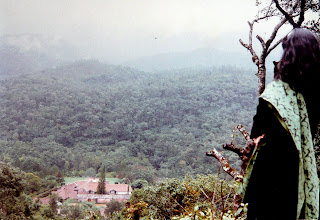A visit to Rajahmundry and the Godavari basin.
Rajahmundry is a town on the banks of river Godavari. Travelers from South India going to the North may have noticed the railway bridge across Godavari in Andhra Pradesh. The Godavari Rail Bridge is 2.75 kilometers long and is reportedly Asia's second longest road-cum-rail bridge crossing a water body, after Japan's Kansai International Airport Sky Gate. By the way, the Vembanad Rail Bridge in Kerala used only for goods traffic is the longest rail bridge in India.
I visited Rajahmundry in the first week of August as part of my official work and the intervening Sunday was used to get a feel of the place. My visits to areas of interests were made more enjoyable in the company of my colleague from Hyderabad Mr.Dhananjay Ram –who had formerly served as the Managing Director of Andhra Bank Financial Services Ltd and as the Secretary to the Banking Service Recruitment Board- and his vivacious son Vijay, a software Engineer with Oracle.

Rajahmundry is an ancient city with a history of over a millennium and is a beautiful place to visit. Situated on the banks of the river Godavari, it is a fertile place with much greenery seen around. The river Godavari, originates in the Western Ghats near Nasik in Maharashtra flows eastwards about 1465 km through the Deccan plateau to join the Bay of Bengal through two mouths near the city.
The Chalukya king Rajaraja Narendra is attributed to the founding of Rajamhendravaram around 1022 AD. The Chalukyas ruled parts of southern and central India between 6th and 12th centuries and reportedly were a branch of the famous Gurjara- Pratihara Kings of North India. Rajahmundry also is known as a place where the Devadasi system prevailed in which nautch girls dedicated to the Gods performed in temples till the system was finally outlawed in India in 1988.


Dowleswaram Barrage and Sir Arthur Thomas Cotton.
Sir Arthur Thomas Cotton (1803-1899) joined the army at the tender age of 15 as a cadet. In 1821 he was sent to Madras Engineers and had occasion to serve the I Burma war. Besides the anicuts of Godavari and Krishna, Cotton’s contributions extend to many other areas as a Delta Architect. He was knighted in 1861 and later honoured with KCSI in 1877.
The Cotton museum in Rajahmundry is dedicated to him and it displays many records and objects connected with the construction of the barrage that happened 150 years ago when many of the modern facilities including electricity or vehicles were not available to the Engineers.

Bhimeswara temple, Draksharama, near Kakinada
While Mr.Dhananjay Ram wanted to go for the religious rites of Abhisheka, at the temple, I was more interested about its antiquity. The guide, Kashi, arranged by him was a typical south Indian Brahmin, like the Pandas of Benares. He went on reminding me that he did not get a salary from the temple and that his income was only from the generous tips of the visitors and devotees like me. Later, I came to know from Vijay that he already owned a shop selling religious paraphernalia in Hyderabad and was about to open another shop in that city as the business was flourishing.
This famous temple, one of the Pancharama temples in South India is about 30 km from Kakinada and the deity Shiva here is known as Bhimeswara. Legends attribute this to the beginning of Kaliyuga but the Archaeological records say that the temple dates back to the 10th century and may have been constructed during the reign of Chalukya Bhima 1 of Eastern Chalukya dynasty (892-922 AD). The inscriptions on the stone walls of the temple include those by Velanadu chiefs, Reddy chiefs of Rajahmundry, Kondavidu rulers, Kings and feudatories of Cholas, Chalukyas etc written in Telugu, Sanskrit, and Tamil and these dates back from 10th to 15th century.
Many interesting legends are attributed to this temple like the sacrifice of Daksha, destruction of Tripuras, creation of Saptha Godavari and the arrival of Lord Shiva to Draksharama.




Bhimeswara Temple, Samarlakotla.
This temple is one of the Pancharama temples and is in Kakinada rural. Here, the deity Shiva is known as Kumara Bhimeswara. The temple is managed by the archaeological department as it was built by the Chalukyas. Construction of the temple had taken place between 9th and 10th centuries like the one at Draksharama.


The city of Rajahmundry left in me happy memories of a whirlwind trip.
Tripunithura,
Athachamayam day, 2011.





Comments
Kind regards,